Nd-Sr Isotopic Study of Magmatic Rocks and 40Ar/39Ar Dating of the Mafic Dike of the Proterozoic Ulan-Sar’dag Ophiolite Mélange (Southern Siberia, East Sayan, Middle Belt, Russia)
Abstract
:1. Introduction
2. Geological Settings
3. Materials and Methods
3.1. Sample Description
3.2. 40Ar/39Ar Isotope Analytical Method
3.3. Sm-Nd Isotope Analytical Method
3.4. Rb-Sr Isotope Analytical Method
4. Results
4.1. 40Ar/39Ar dating of the Mafic Dike
4.2. Geochemical Features and Nd-Sr Isotopes
5. Discussion
5.1. Constraints on Mantle Source
5.2. Comparison Isotope Data of Ulan-Sar’dag Massif with Ospa–Kitoi and Dunzhugur Massifs
5.3. Isotopic Evidence of Crust–Mantle Interaction
5.4. The Stages of Magmatism of the Ulan-Sar’dag Massif
6. Conclusions
- The Ulan-Sar’dag massif consists of various structurally combined material blocks–ophiolite ultramafic–mafic rocks with podiform chromitites, cumulative gabbro, foliated serpentinites, island-arc assemblage, mafic dikes. Four isotope geochemical types of the magmatic rocks of the USM have been established.
- The ophiolites of the Eastern Sayan belong to the supra subduction type. The first isotopic data on the magmatic rocks of the USM was obtained. Isotope geochemical characteristics of the magmatic rocks of the USM reflect the evolution of island arc magmatism and subduction zone. The boninite was formed from a depleted mantle source, and the island-arc assemblage was originated from an enriched mantle source which results from the subduction of terrigenous matter. The calculated proportion of the crustal component was from 14% to 45%. The source of the terrigenous material was most likely the rocks of the Archean TTG complex of the Gargan block. The E-MOR and OIB-like basalts and mafic dike were probably generated by mixing island-arc melts with asthenospheric melts produced from upwelling asthenosphere and decompression melting.
- A whole-rock 40Ar/39Ar weighted mean plateau age of 799 ± 11 Ma constrains the minimum age of the ophiolite mélange in the region, implying that all accretion ended in the early Neoproterozoic (late Tonian).
- The Ulan-Sar’dag Massif is a member of the Proterozoic ophiolite and island-arc systems in the CAOB. They have subduction geochemical characteristics and were formed on the Neoproterozoic active continental margin of the Siberian paleocontinent. Proterozoic ophiolite and island-arc systems were associated with the evolution of the Paleo-Asian ocean in the period 1050–790 Ma. The island-arc assemblage of the Ulan-Sar’dag massif has geochemical characteristics of both ensimatic and ensialic island arcs. The stage of the initiation of ensimatic island arc magmatism in the Paleo-Asian ocean occurred in the time fence of 1050–790 Ma and is most widely developed in the Eastern Sayan, Northern and Eastern Baikal Lakeside, Mongolia. The initiation of ensialic arc magmatism on the Neoproterozoic active margin occurred 830–780 Ma (Eastern Sayan, Central Transbaikalia, Mongolia). The formation of plumes associated with the melting of slabs plunging into the subduction zone and the participation of asthenospheric melts in island-arc magmatism occurred at the boundary of 820–770 Ma in almost all Neoproterozoic island-arc systems with the formation of subalkaline enriched alkaline magmatic series. The collisional granites formed at the 750 Ma boundary recorded collisional-orogenic events and accretion of island arcs at the Proterozoic stage.
Supplementary Materials
Author Contributions
Funding
Acknowledgments
Conflicts of Interest
References
- Dobretsov, N.L. (Ed.) Geology and Metamorphism of East Sayan; Nauka Publ. House: Novosibirsk, Russia, 1988; p. 190. (In Russian) [Google Scholar]
- Sengör, A.M.C.; Natal’in, B.A. Palaeotectonics of Asia: Fragments of a synthesis. In The Tectonic Evolution of Asia; Yin, A., Harrison, T.M., Eds.; Cambridge University Press: Cambridge, UK, 1996; pp. 486–640. [Google Scholar]
- Torsvik, T.H.; Smethurst, M.A.; Meert, J.G.; Van der Voo, R.; McKerrow, W.S.; Brasier, M.D.; Sturt, B.A.; Walderhaug, H.J. Continental break-up and collision in the Neoproterozoic and Paleozoic—A tale of Baltica and Laurentia. Earth Sci. Rev. 1996, 40, 229–258. [Google Scholar] [CrossRef]
- Kuzmichev, A.V. The Central Asian Fold Belt. Geology, Evolution, Tectonics and Models; Kröner, A., Ed.; Burntraeger Science Publisher: Studgard, Germany, 2015. [Google Scholar]
- Dobretsov, N.L.; Buslov, M.M.; Vernikovsky, V.A. Neoproterozoic to Early Ordovician evolution of the Paleo-Asian ocean: Implications to the break-up of Rodinia. Gondwana Res. 2003, 6, 143–159. [Google Scholar] [CrossRef]
- Zhmodik, S.M.; Postnikov, A.A.; Buslov, M.M.; Mironov, A.G. Geodynamics of the Sayan-Baikal-Muya accretion-collision belt in the Neoproterozoic-early Paleozoic and regularities of the formation and localization of precious-metal mineralization. Russ. Geol. Geophys. 2006, 1, 183–198. [Google Scholar]
- Windley, B.F.; Alexeiev, D.; Xiao, W.J.; Kröner, A.; Badarch, G. Tectonic models for accretion of the Central Asian Orogenic Belt. J. Geol. Soc. Lond. 2007, 164, 31–47. [Google Scholar] [CrossRef] [Green Version]
- Dobretsov, N.L.; Konnikov, E.G.; Dobretsov, N.N. Precambrian ophiolitic belts of Southern Siberia (Russia) and their metallogeny. Precambrian Res. 1992, 58, 427–446. [Google Scholar] [CrossRef]
- Sklyarov, E.V.; Gladkochub, D.P.; Mazukabzov, A.M.; Men’shagin, Y.V.; Konstantinov, K.M.; Watanabe, T. Dike swarms of southern flank of Siberian craton—Indicators of Rodinia supercontinent breakup. Geotektonika 2000, 6, 59–70. [Google Scholar]
- Buslov, M.M.; Saphonova, I.Y.; Watanabe, T.; Obut, O.T.; Fujiwara, Y.; Iwata, K.; Semakov, N.N.; Sugai, Y.; Smirnova, L.V.; Kazansky, A.Y. Evolution of the Paleo-Asian ocean (Altai–Sayan region, Central Asia) and collision of possible Gondwana-derived terranes with the southern marginal part of the Siberian continent. Geosci. J. 2001, 5, 203–224. [Google Scholar] [CrossRef]
- Meert, J.G.; Torsvik, T.H. The making and unmaking of a supercontinent: Rodinia revisited. Tectonophysics 2003, 375, 261–288. [Google Scholar] [CrossRef]
- Yarmolyuk, V.V.; Kovalenko, V.I. Late Riphean breakup between Siberia and Laurentia: Evidence from intraplate magmatism. Dokl. Earth Sci. 2001, 379, 525–552. [Google Scholar]
- Yarmolyuk, V.V.; Kovalenko, V.I.; Kozlovsky, A.M.; Kudryashova, E.A.; Anisimova, I.V.; Sal’nikova, E.B.; Kovach, V.P.; Kozakov, I.K.; Kotov, A.B.; Plotkina, Y.V.; et al. Late Riphean alkali granites of the Zabhan microcontinent: Evidence for the timing of Rodinia breakup and formation of microcontinents in the Central Asian fold belt. Dokl. Earth Sci. 2008, 420, 583–588. [Google Scholar] [CrossRef]
- Xiao, W.J.; Kusky, T.M. Geodynamic processes and metallogenesis of the Central Asian and related orogenic belts: Introduction. Gondwana Res. 2009, 16, 167–169. [Google Scholar] [CrossRef]
- Xiao, W.J.; Huang, B.C.; Han, C.M.; Sun, S.; Li, J.L. A review of the western part of the Altaids: A key to understanding the architecture of accretionary orogens. Gondwana Res. 2010, 18, 253–273. [Google Scholar] [CrossRef]
- Aktanov, V.I.; Dorinna, N.A.; Posokhov, V.F.; Sklyarov, E.B.; Skopintsev, V.G. On the age and structure of the Gargan massif (south eastern Sayan) [abs.]. In Proceedings of the Conference on Structural Analyses of Crystalline Complexes, Irkutsk, Russia, 17–22 May 1992; Melnikov, A.I., Ed.; Institute of the Earth’s Crust RAS: Irkutsk, Russia, 1992; pp. 89–90. (In Russian). [Google Scholar]
- Dobretsov, N.L.; Buslov, M.M.; Safonova, I.Y.; Kokh, D.A. Fragments of oceanic islands in the Kurai and Katun’ accretionary wedges of Gorny Altai. Russ. Geol. Geophys. 2004, 45, 1325–1348. [Google Scholar]
- Letnikova, E.F.; Geletii, N.K.; Sklyarov, E.V. Lithological and Geochemical Features of Carbonate Rocks in the Sedimentary Cover of the Gargan Terrain, Southeastern East Sayan. Gondwana Res. 2001, 4, 680. [Google Scholar] [CrossRef]
- Kuzmichev, A.B.; Bibikova, E.V.; Zhuravlev, D.Z. Neoproterozoic (~800 Ma) orogeny in the Tuva– Mongolia Massif (Siberia): Island arc–continent collision at the northeast Rodinia margin. Precambrian Res. 2001, 110, 109–126. [Google Scholar] [CrossRef]
- Khain, E.V.; Bibikova, E.V.; Kröner, A.; Zhuravlev, D.Z.; Sklyarov, E.V.; Fedotova, A.A.; Kravchenko-Berezhnoy, I.R. The most ancient ophiolite of the Central Asian fold belt: U–Pb and Pb–Pb zircon ages for the Dunzhugur Complex, Eastern Sayan, Siberia, and geodynamic implications. Earth Planet. Sci. Lett. 2002, 199, 311–325. [Google Scholar] [CrossRef]
- Kuzmichev, A.B.; Larionov, A.N. Neoproterozoic island arcs of East Sayan: Duration of magmatism (from U-Pb zircon dating of volcanic clastics). Russ. Geol. Geophys. 2013, 54, 34–43. [Google Scholar] [CrossRef]
- Kiseleva, O.N.; Zhmodik, S.M.; Damdinov, B.B.; Agafonov, L.V.; Belyanin, D.K. Composition and evolution of PGE mineralization in chromite ores from the Il’chir ophiolite complex (Ospa–Kitoi and Khara-Nur areas, East Sayan). Russ. Geol. Geophys. 2014, 55, 259–272. [Google Scholar] [CrossRef]
- Kiseleva, O.; Zhmodik, S. PGE mineralization and melt composition of chromitites in Proterozoic ophiolite complexes of Eastern Sayan, Southern Siberia. Geosci. Front. 2017, 8, 721–731. [Google Scholar] [CrossRef] [Green Version]
- Kiseleva, O.N.; Airiyants, E.V.; Belyanin, D.K.; Zhmodik, S.M. Podiform chromitites and PGE mineralization in the Ulan-Sar’dag ophiolite (East Sayan, Russia). Minerals 2020, 10, 141. [Google Scholar] [CrossRef] [Green Version]
- Kiseleva, O.N.; Airiyants, E.V.; Belyanin, D.K.; Zhmodik, S.M. Geochemical Features of Peridotites and Volcanogenic-Sedimentary Rocks of the Ultrabasic-Basitic Massif of Ulan Sar’dag (East Sayan, Russia); The Bulletin of Irkutsk State University: Irkutsk, Russia, 2019; (In Russian). [Google Scholar] [CrossRef]
- Kiseleva, O.N.; Airiyants, E.V.; Belyanin, D.K.; Zhmodik, S.M.; Ashchepkov, I.V.; Kovalev, S.A. Multistage magmatism in ophiolites and associated metavolcanites of the Ulan-Sar´dag Mélange (East Sayan, Russia). Minerals 2020, 10, 1077. [Google Scholar] [CrossRef]
- Fedorovskii, V.S.; Khain, E.V.; Vladimirov, A.G.; Kargopolov, S.A.; Gibsher, A.S.; Izokh, A.E. Tectonics, metamorphism, and magmatism of collisional zones of the Central Asian Caledonides. Geotectonics 1995, 29, 193–212. [Google Scholar]
- Khain, E.; Gusev, G.S.; Khain, E.V.; Vernikovsky, V.A.; Volobuev, M.I. Circum-Siberian Neoproterozoic Ophiolite Belt. Ofioliti 1992, 22, 195–200. [Google Scholar]
- Sklyarov, E.V.; Kovach, V.P.; Kotov, A.B.; Kuzmichev, A.B.; Lavrenchuk, A.V.; Perelyaev, V.I.; Shchipansky, A.A. Boninites and ophiolites: Problems of their relations and petrogenesis of boninites. Russ. Geol. Geophys. 2016, 57, 127–140. [Google Scholar] [CrossRef]
- Belyaev, V.A.; Wang, K.-L.; Gornova, M.A.; Dril, S.I.; Karimov, A.A.; Medvedev, A.Y.; Noskova, Y.V. Geochemistry and origin of the Eastern Sayan ophiolites, Tuva-Mongolian microcontinent (Southern Siberia). Geodyn. Tectonophys. 2017, 8, 411415. [Google Scholar] [CrossRef] [Green Version]
- Wang, K.; Chu, Z.; Gornova, M.; Dril, S.; Belyaev, V.; Lin, K.; O’Reilly, S. Depleted SSZ type mantle peridotites in Proterozoic Eastern Sayan ophiolites in Siberia. Geodyn. Tectonophys. 2017, 8, 583–587. [Google Scholar] [CrossRef] [Green Version]
- Belyaev, V.A. Boninite-tholeiite association in Mesoproterozoic Eastern Sayan ophiolites: Geochemistry and mineralogy of lavas, dikes, and cumulates. In Proceedings of the IX Siberian Conference of Young Scientists on Geosciences, Novosibirsk, Russia, 19–23 November 2018; Kruk, N.N., Yeltsov, I.N., Vernikovsky, V.A., Eds.; V.S. Sobolev Institute of Geology and Mineralogy SB RAS, A.A. Trofimuk Institute of Oil and Gas Geology and Geophysics SB RAS, Novosibirsk State University: Novosibirsk, Russia, 2018; pp. 60–62. (In Russian). [Google Scholar]
- Belyaev, V.A.; Gornova, M.A.; Wang, K.-L.; Korneva, A.P.; Karimov, A.A.; Medvedev AYa Dril, S.I.; Semiryakov, A.S.; Agasheva, E.A. Mezoproterozoic ophiolites of Eastern Sayan: U-Pb age of zircon (LA—ICP—MS) and geodynamic conditions of formation [abs.]. In Proceedings of the Russian Conference with International Participation on Dynamics and Interaction of the Earth´s Geosphere, Tomsk State University, Tomsk, Russia, 8–11 November 2021; Tomsk Publisher House: Tomsk, Russia, 2021; pp. 232–233. (In Russian) [Google Scholar]
- Gordienko, I.V.; Dobretsov, N.L.; Zhmodik, S.M.; Roschektayev, P.A. Multistage thrust and nappe tectonics on the southeastern part the eastern sayan and its role in the formation of large gold deposits. Russ. Geol. Geophys. 2021, 62, 109–120. [Google Scholar] [CrossRef]
- Rudnev, S.N.; Gibsher, A.S.; Semenova, D.V. Vendian island arc intrusive magmatism of the Lake zone of Western Mongolia geological, geochronological, and petrochemical data). Russ. Geol. Geophys. 2021, 62, 619–632. [Google Scholar] [CrossRef]
- Gibsher, A.S. Microcontinent of the Central Asian Mobile Belt. In Proceedings of the Conference on Geodynamic Evolution of the Central Asian Mobile Belt (from Ocean to Continent), Irkutsk, Russia, 17–20 October 2017; pp. 49–51. (In Russian). [Google Scholar]
- Kuzmichev, A.; Kröner, A.; Hegner, E.; Liu, D.Y.; Wan, Y.S. The Shishkhid ophiolite, northern Mongolia: A key to the reconstruction of a Neoproterozoic island-arc system in central Asia. Precambrian Res. 2005, 138, 125–150. [Google Scholar] [CrossRef]
- Travin, A.V.; Yudin, D.S.; Vladimirov, A.G.; Khromykh, S.V.; Volkova, N.I.; Mekhonoshin, A.S.; Kolotilina, T.B. Thermochronology of the Chernorud granulite zone, Ol’khon region, Western Baikal area. Geochem. Int. 2009, 47, 1107–1124. [Google Scholar] [CrossRef] [Green Version]
- Baksi, A.K.; Archibald, D.A.; Farrar, E. Intercalibration of 40Ar/39Ar dating standards. Chem. Geol. 1996, 129, 307–324. [Google Scholar] [CrossRef]
- Lee, J.-Y.; Marti, K.; Severinghaus, J.P.; Kawamura, K.; Yoo, H.-S.; Lee, J.B.; Kim, J.S. A redetermination of the isotopic abundances of atmospheric Ar. Geochim. Cosmochim. Acta 2006, 70, 4507–4512. [Google Scholar] [CrossRef]
- Raczek, I.; Jochum, K.P.; Hofmann, A.W. Neodymium and strontium isotope data for USGS reference materials BCR-1, BCR-2, BHVO-1, BHVO-2, AGV-1, AGV-2, GSP-1, GSP-2 and eight MPI-DING reference glasses. Geostand. Newsl. 2003, 27, 173–179. [Google Scholar] [CrossRef]
- Tanaka, T.; Togashi, S.; Hikari, K.; Hiroshi, A.; Hiroo, K.; Takuji, T.; Masaki Yu Yuji, O.; Shigekazu Yo Kunimaru, H.; Takahashi, T.; Yanagi, K.; et al. JNdi-1: A neodymium isotopic reference in consistency with LaJolla neodymium. Chem. Geol. 2000, 168, 279–281. [Google Scholar] [CrossRef]
- Bouvier, A.; Vervoort, J.D.; Patchett, P.J. The Lu–Hf and Sm–Nd isotopic composition of CHUR: Constraints from unequilibrated chondrites and implications for the bulk composition of terrestrial planets. Earth Planet. Sci. Lett. 2008, 273, 48–57. [Google Scholar] [CrossRef]
- Weis, D.; Kieffer, B.; Maerschalk, C.; Barling, J.; Jong, J.; Williams, G.A.; Hanano, D.; Pretorius, W.; Mattielli, N.; Scoates, J.S.; et al. High-precision isotopic characterization of USGS reference materials by TIMS and MCICP-MS. Geochem Geophys Geosyst 2006, 7, 139–149. [Google Scholar] [CrossRef]
- Sun, S.S.; McDonough, W.F. Chemical and isotopic systematics of oceanic basalts; implications for mantle composition and processes. In Magmatism in the Ocean Basins; Saunders, A.D., Norry, M.J., Eds.; Geological Society: London, UK, 1989; Volume 42, pp. 313–345. [Google Scholar] [CrossRef]
- Pearce, J.A.; Van der Laan, S.R.; Arculus, R.J.; Murton, B.J.; Ishii, T.; Peate, D.W.; Parkinson, I.J. Boninite and harzburgites from Leg 125 (Bonin-Mariana forearc): A case study of magma genesis during the initial stages of subduction. In Proceedings of the Ocean Drilling Program, 125, Scientific Results; Fryer, P., Pearce, J.A., Stokking, L.B., Ali, J.R., Arculus, R., Balotti, D., Burke, M.M., Ciampo, G., Haggerty, J.A., Haston, R.B., et al., Eds.; Ocean Drilling Program: College Station, TX, USA, 1992; Volume 125, pp. 623–659. [Google Scholar] [CrossRef]
- Taylor, S.R.; McLennan, S.M. The Continental Crust: Its Evolution and Composition; Blackwell: London, UK, 1985; 312p. [Google Scholar]
- Jacobsen, S.B.; Wesserburg, G.J. Sm-Nd evolution of chondrites and achondrites. Earth Planet. Sci. Lett. 1984, 67, 137–150. [Google Scholar] [CrossRef]
- Faure, G. Principles of Isotope Geology, 2nd ed.; Wiley and Sons: New York, NY, USA, 1986; 589p. [Google Scholar]
- Taylor, H.P. The effect of assimilation of rocks by magmas: 18O/16O and 87Sr/86Sr systematics in igneous rocks. Earth Planet. Sci. Lett. 1980, 47, 243–254. [Google Scholar] [CrossRef]
- Pokrovsky, B.G. Crustal Contamination of Mantle Magmas According to Isotope Geochemistry; Nauka: Moscow, Russia, 2000; p. 225. (In Russian) [Google Scholar]
- Kuznetsov, A.B.; Ovchinnikova, G.V.; Gorokhov, I.M.; Vasil’eva, I.M.; Gorokhovskii, B.M.; Semikhatov, M.A.; Kaurova, O.K.; Krupenin, M.T.; Maslov, A.V. The Sr isotopic characterization and Pb-Pb age of carbonate rocks from the Satka formation, the lower Riphean Burzyan group of the Southern Urals. Stratigr. 2008, 16, 120–137. [Google Scholar] [CrossRef]
- Kuznetsov, A.B.; Letnikova, E.F.; Vishnevskaya, I.A.; Konstantinova, G.V.; Kutyavin, E.P.; Geletiy, H.K. Sr chemostratigraphy of carbonate sedimental cover of the Tuvino-Mongolsk microcontinent. Dokl. Earth Sci. 2010, 432, 350–355. [Google Scholar] [CrossRef]
- Kovach, V.P.; Kotov, A.B.; Terent’eva, L.B.; Yarmolyuk, V.V.; Kovalenko, V.I.; Kozlovskyi, A.M. Composition, sources, and mechanisms of formation of the continental crust of the Lake zone of the Central Asian caledonides. II. Geochemical and Nd isotope data. Petrology 2011, 19, 399–425. [Google Scholar] [CrossRef]
- Munker, C.; Worner, G.; Yogodzinski, G.M.; Churicova, T.G. Behaviour of high field strength elements in subduction zone: Constrains from Kamchatka-Aleutian arc lavas. Earth Planet. Sci. Lett. 2004, 224, 275–293. [Google Scholar] [CrossRef]
- Kovach, V.P.; Kozakov, I.K.; Kroner, A.; Salnikova, E.; Wang, K.-L.; Lee, H.-Y.; Chung, S.-L. Early Neoproterozoic crust formation in the Dzabkhan microcontinent, Central Asian Orogenic Belt. Geodynam. Tectonophys. 2017, 8, 499–501. [Google Scholar] [CrossRef] [Green Version]
- DePaolo, D.J.; Wasserburg, G.J. The sources of island arcs as indicated by Nd and Sr isotopic studies. Geophys. Res. Lett. 1977, 4, 465–468. [Google Scholar] [CrossRef] [Green Version]
- Whitford, D.J.; Compston, W.; Nicholls, I.A.; Abbot, M.J. Geochemistry of late Cenozoic lavas from eastern Indonesia: Role of subducted sediments in petrogenesis. Geology 1977, 5, 571–575. [Google Scholar] [CrossRef]
- Vorontsov, A.; Yarmolyuk, V.; Fedoseev, G.; Nikiforov, A.; Sandimirova, G. Isotopic and Geochemical Zoning of Devonian Magmatism in the Altai–Sayan Rift System: Composition and Geodynamic Nature of Mantle Sources. Petrology 2010, 18, 596–609. [Google Scholar] [CrossRef]
- Kröner, A.; Kovach, V.; Alexeiev, D.; Wang, K.-O.; Wong, J.; Degtyarev, K.; Kozakov, I. No excessive crustal growth in the Central Asian Orogenic Belt: Further evidence from field relationships and isotopic data. Gondwana Res. 2017, 50, 135–166. [Google Scholar] [CrossRef] [Green Version]
- Turkina, O.M.; Sukhorukov, V.P.; Sergeev, S.A. Mesoarchean bimodal volcanic rocks of the Onot greenstone belts, southwestern Siberian craton: Implications for magmatism in an extension/rift setting. Precambrian Res. 2020, 343, 105731. [Google Scholar] [CrossRef]
- Kovalenko, V.I.; Yarmolyuk, V.V.; Kovach, V.P.; Kotov, A.B.; Sal’nikova, E.B. Magmatism and geodynamics of early Caledonian structures of the Central Asian fold belt (isotopic and geological data). Russ. Geol. Geophys. 2003, 12, 1235–1248. [Google Scholar]
- Jahn, B.M.; Wu, F.; Chen, B. Massive granitoid generation in Central Asia: Nd isotope evidence and implication for continental growth in the Phanerozoic. Episodes 2000, 23, 82–92. [Google Scholar] [CrossRef] [Green Version]
- Zindler, A.; Hart, S.R.; Brooks, C. The Shabogamo Intrusive Suite, Labrador: Sr and Nd isotopic evidence for contaminated mafic magmas in the Proterozoic. Earth Planet. Sci. Lett. 1981, 54, 217–235. [Google Scholar] [CrossRef]
- Amelin Yu, V.; Neymark, L.A.; Ritsk EYu Nemchin, A.A. Enriched Nd–Sr–Pb Isotopic Signatures in the Dovyren Layered Intrusion (Eastern Siberia, Russia): Evidence for Contamination by Ancient Upper Crustal Material. Chem. Geol. 1996, 129, 39–69. [Google Scholar] [CrossRef]
- Ishizaka, K.; Karlson, R.W. Nd-Sr systematics of tl1e Setouchi volcanic rocks, southwest Japan: A clue to the origin of orogenic andesites. Earth Planet. Sci. Lett. 1983, 64, 327–340. [Google Scholar] [CrossRef]
- McCulloch, M.T.; Perfit, M.R. 143Nd/144Nd, 87Sr/86 Sr and trace element constraints on the petrogenesis of Aleutian island arc magmas. Earth Planet. Sci. Lett. 1981, 56, 167–179. [Google Scholar] [CrossRef]
- Schaaf, P.; Heinrich, W.; Besch, T. Composition and Sm-Nd isotopic data of the lower crust beneath San Luis Potosi, Central Mexico: Evidence from granulite-facies xenolith suite. Chem Geol. 1994, 118, 63–84. [Google Scholar] [CrossRef]
- Kempton, P.D.; Harmon, R.S.; Hawkesworth, C.J.; Moorbath, S. Petrology and geochemistry of lower crustal granulites from the Geronimo Volcanic Field, southern Arizona. Geochim. Cosmochim. Acta 1990, 54, 3401–3426. [Google Scholar] [CrossRef]
- Zindler, A.; Hart, S. Chemical geodynamics. Annu. Rev. Earth Planet. Sci. 1986, 14, 493–571. [Google Scholar] [CrossRef]
- Hart, S.R. Heterogeneous mantle domains: Signatures, genesis, and mixing chronologies. Earth Planet. Sci Lett. 1988, 90, 273–296. [Google Scholar] [CrossRef]
- Pe-Piper, G. The nature of Triassic extension-related magmatism in Greece: Evidence from Nd and Pb isotope geochemistry. Geol. Magaz. 1998, 135, 331–348. [Google Scholar] [CrossRef]
- Gianni, G.M.; Lujan, S.P. Geodynamic controls on magmatic arc migration and quiescence. Earth Sci. Rev. 2021, 218, 103676. [Google Scholar] [CrossRef]
- Sisson, V.B.; Pavlis, T.L.; Roeske, S.M.; Thorkelson, D.J. Introduction: An overview of ridge-trench interactions in modern and ancient settings. Geol. Soc. Am. Spec. Pap. 2003, 371, 1–18. [Google Scholar]
- Rabayrol, F.; Hart, C.J.R.; Thorkelson, D.J. Temporal, spatial and geochemical evolution of late Cenozoic post-subduction magmatism in central and eastern Anatolia, Turkey. Lithos 2019, 336-337, 67–96. [Google Scholar] [CrossRef]
- Vescheva, S.V.; Turkina, O.M.; Letnikova, E.F.; Ronkin, Y.L. Geochemical and Sm–Nd isotopic characteristics of the Neoproterozoic terrigenous rocks of the Tuva– Mongolian Massif. Dokl. Earth Sci. 2008, 418, 155–160. [Google Scholar] [CrossRef]
- Kovach, V.P.; Jian, P.; Yarmolyuk, V.V.; Kozakov, I.K.; Liu, D.; Terent’eva, L.B.; Lebedev, V.I.; Kovalenko, V.I. Magmatism and geodynamics of early stages of the Paleo Asian ocean formation: Geochronological and geochemical data on ophiolites of the Bayan-Khongor zone. Doklady Earth Sci. 2005, 404, 1072–1077. [Google Scholar]
- Fitton, J.G.; Saunders, A.D.; Norry, M.J.; Hardarson, B.S.; Taylor, R.N. Thermal and chemical structure of the Iceland plume. Earth Planet. Sci. Lett. 1997, 153, 197–208. [Google Scholar] [CrossRef]
- Gordienko, I.V.; Metelkin, D.V. The evolution of the subduction zone magmatism on the Neoproterozoic and Early Paleozoic active margins of the Paleoasian Ocean. Russ. Geol. Geophys. 2016, 57, 69–81. [Google Scholar] [CrossRef]
- Gordienko, I.V. Relationship between subduction-related and plume magmatism at the active boundaries of lithospheric plates in the interaction zone of the Siberian continent and Paleoasian Ocean in the Neoproterozoic and Paleozoic. Geodyn. Tectonophys. 2019, 10, 405–457. [Google Scholar] [CrossRef] [Green Version]
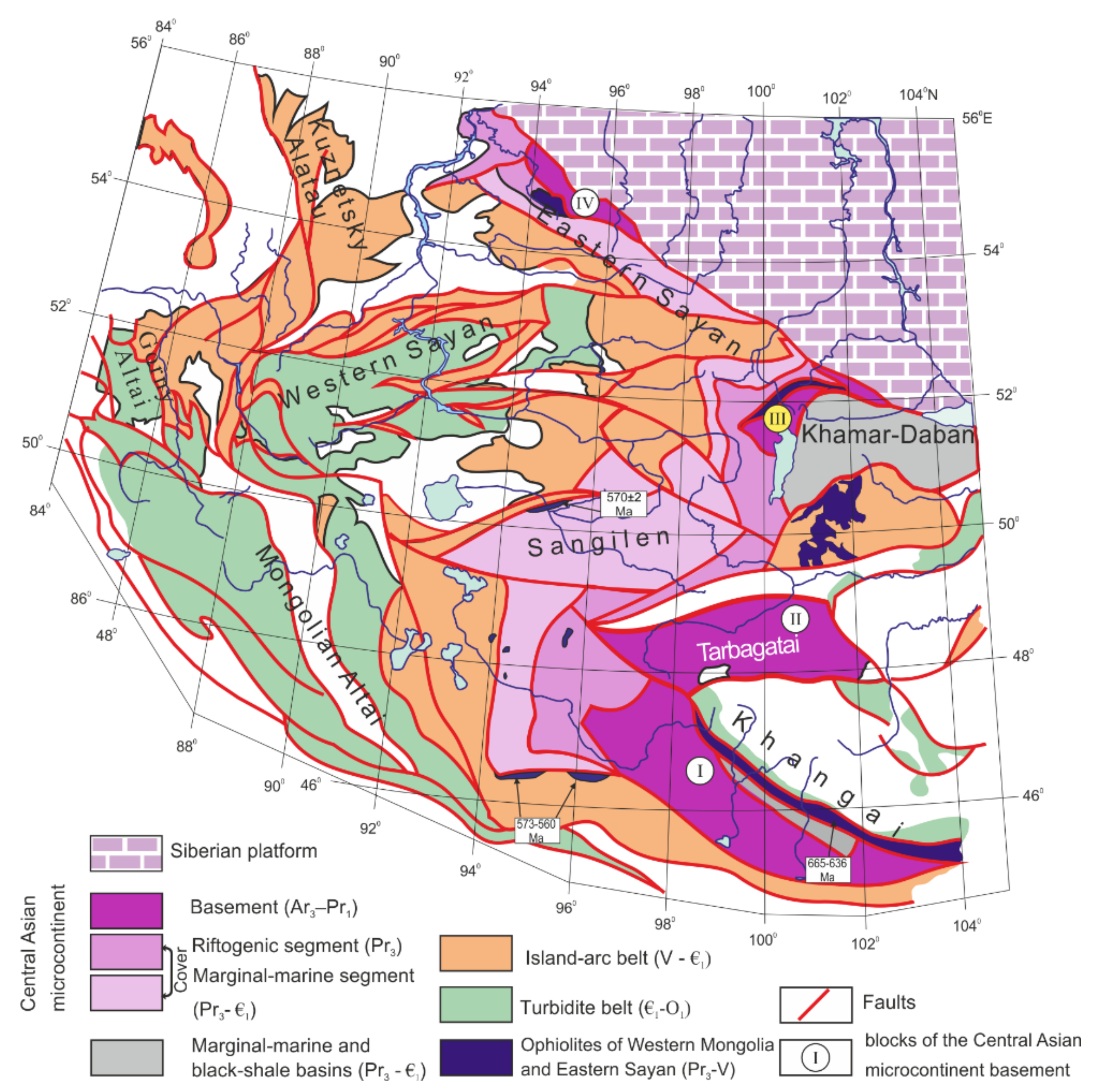

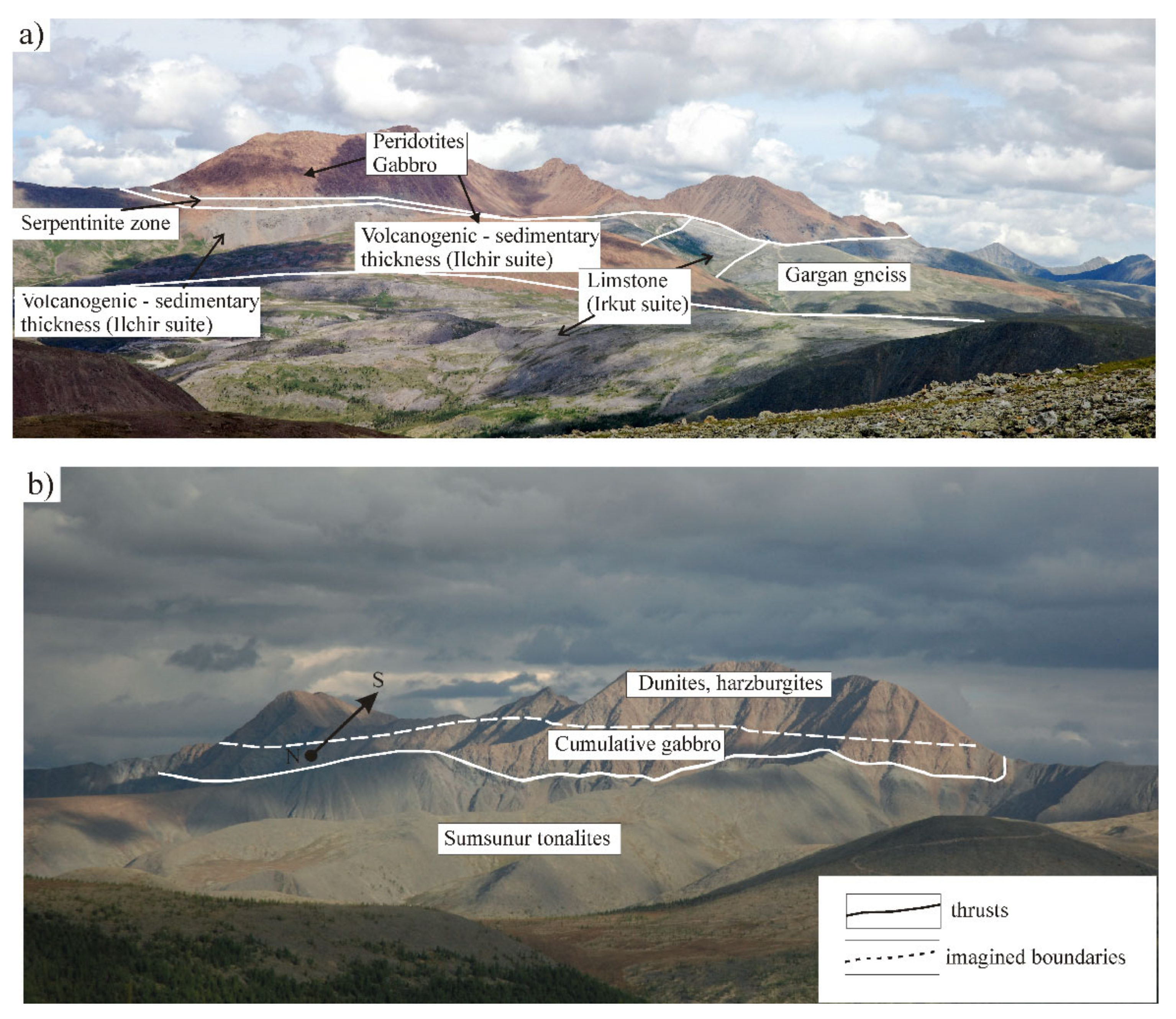
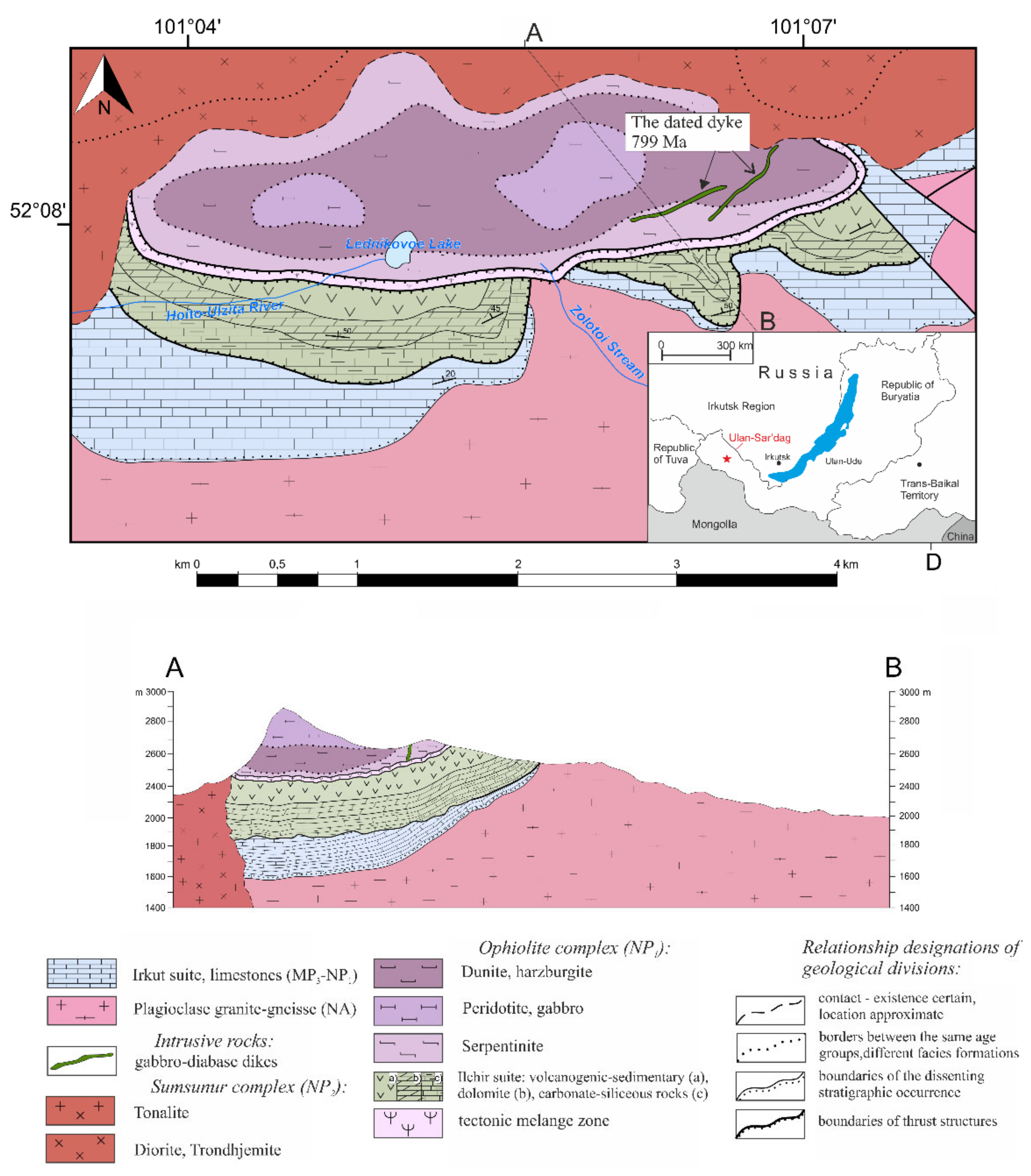
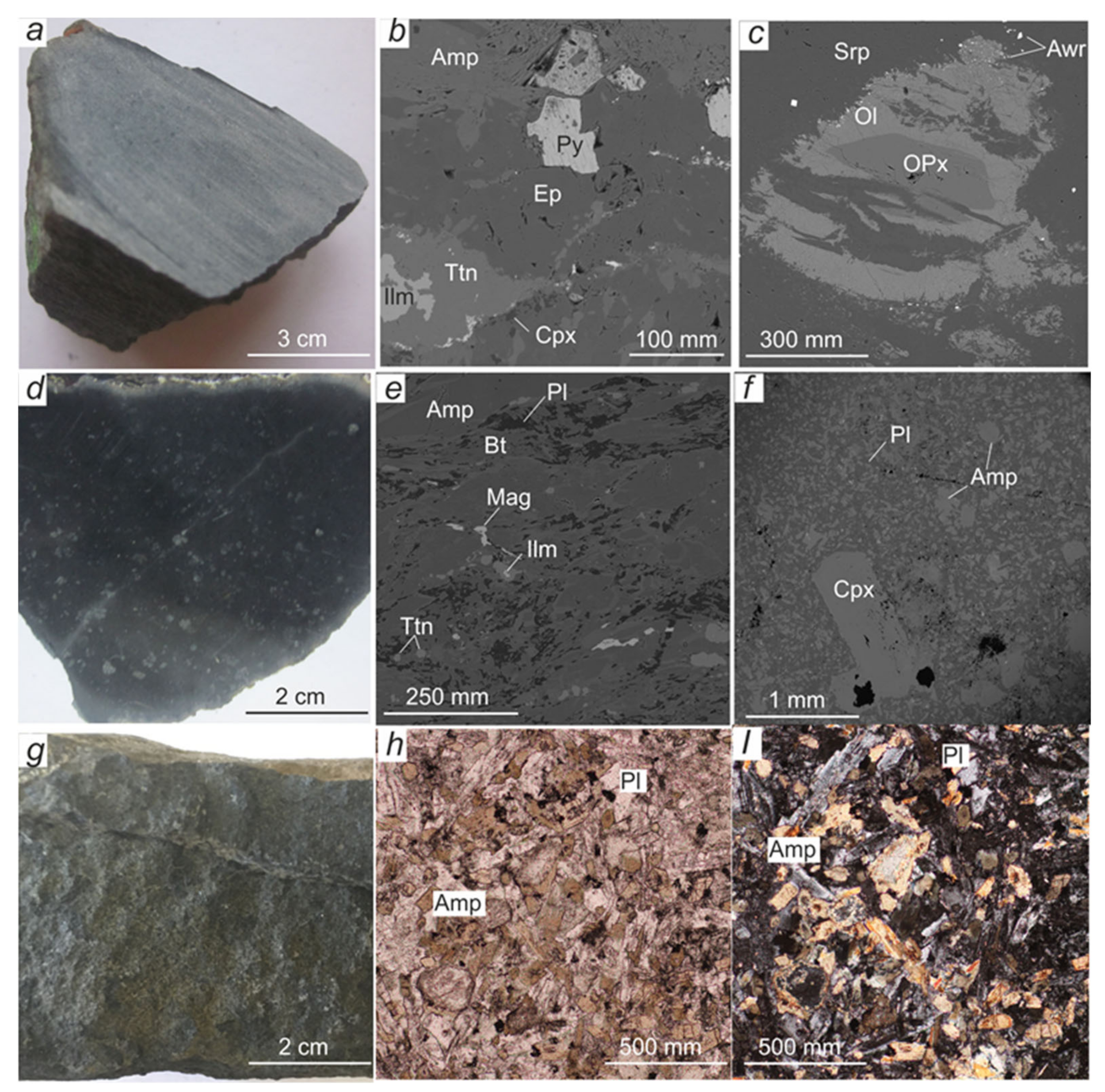

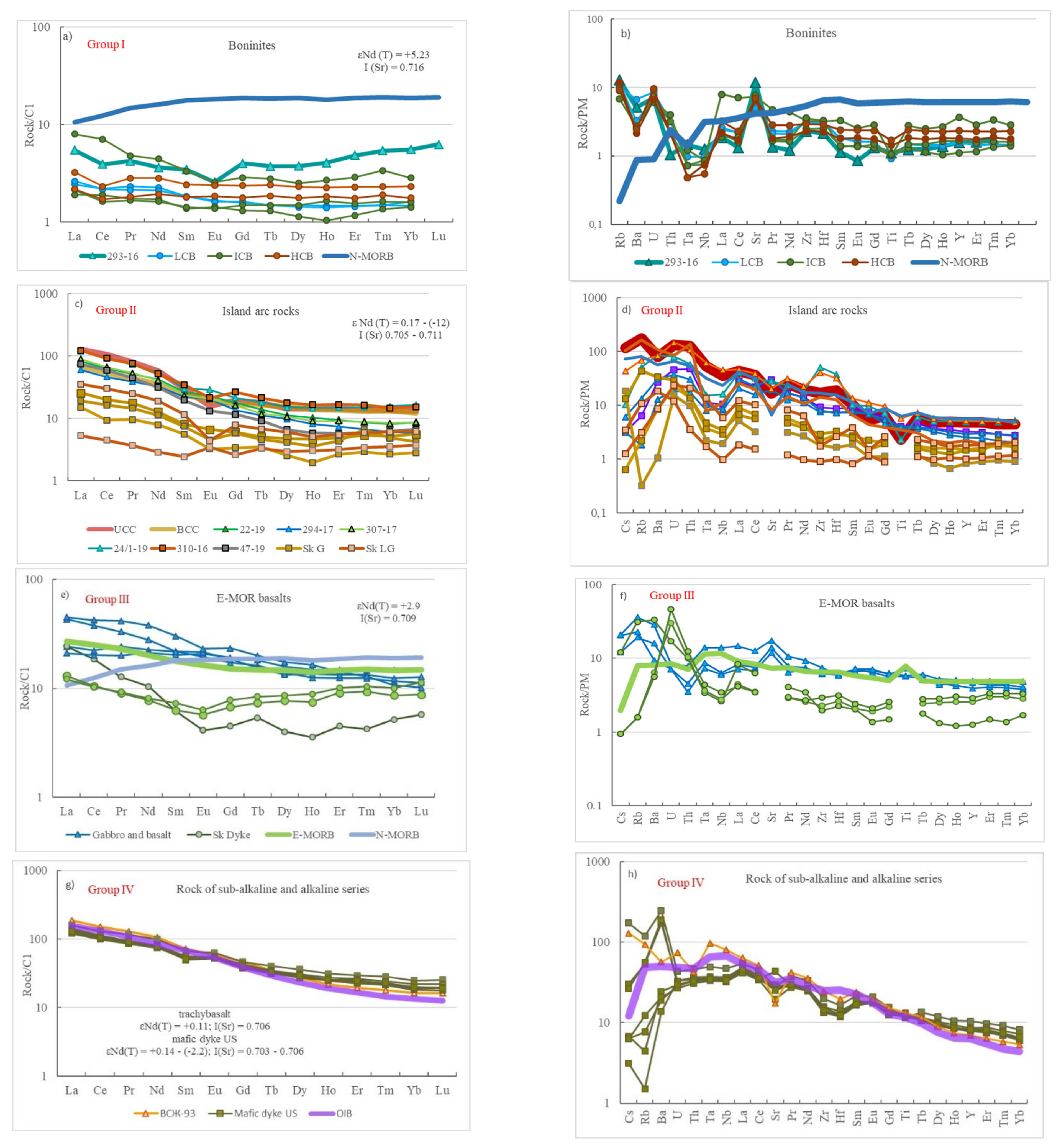
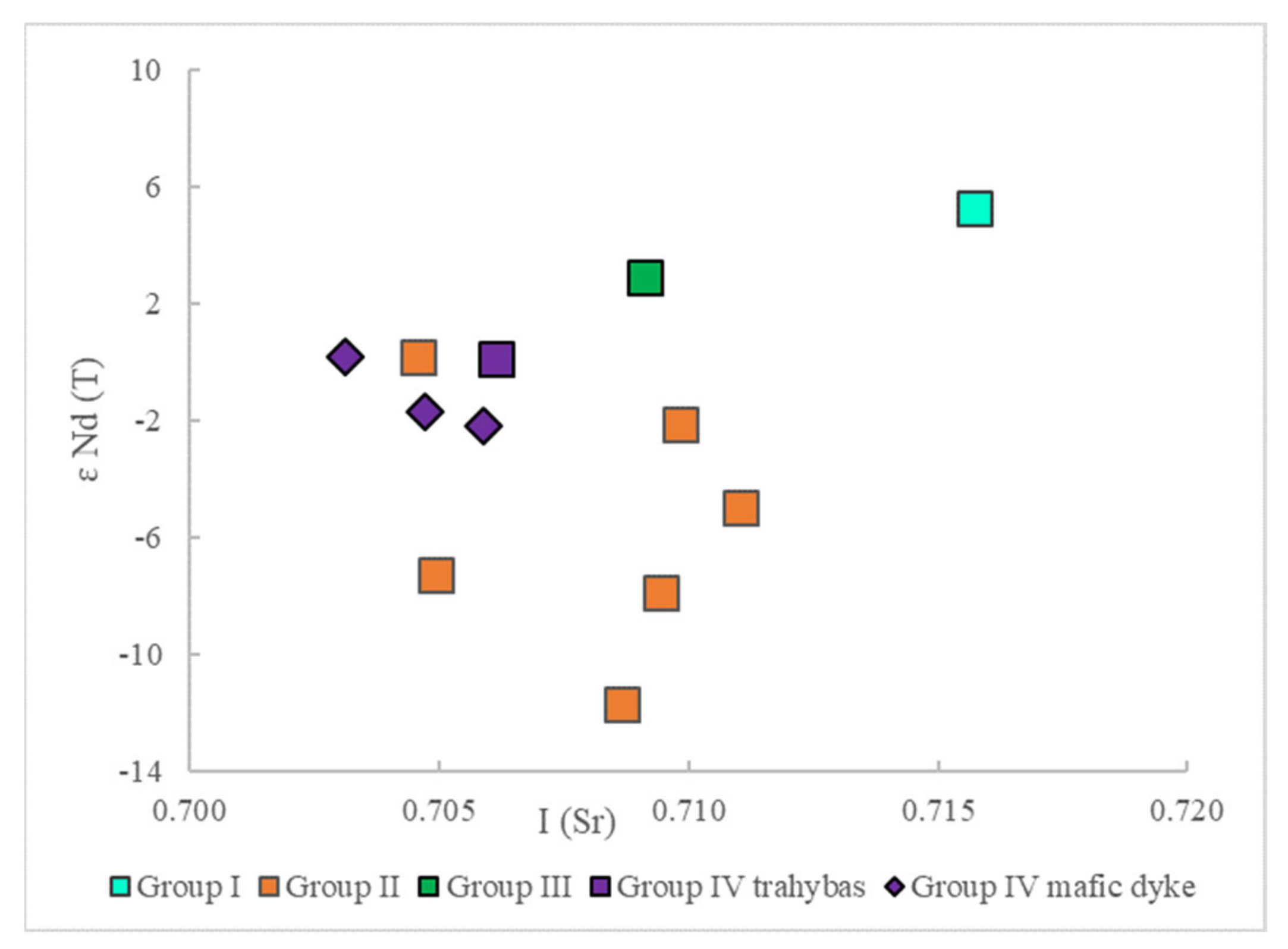




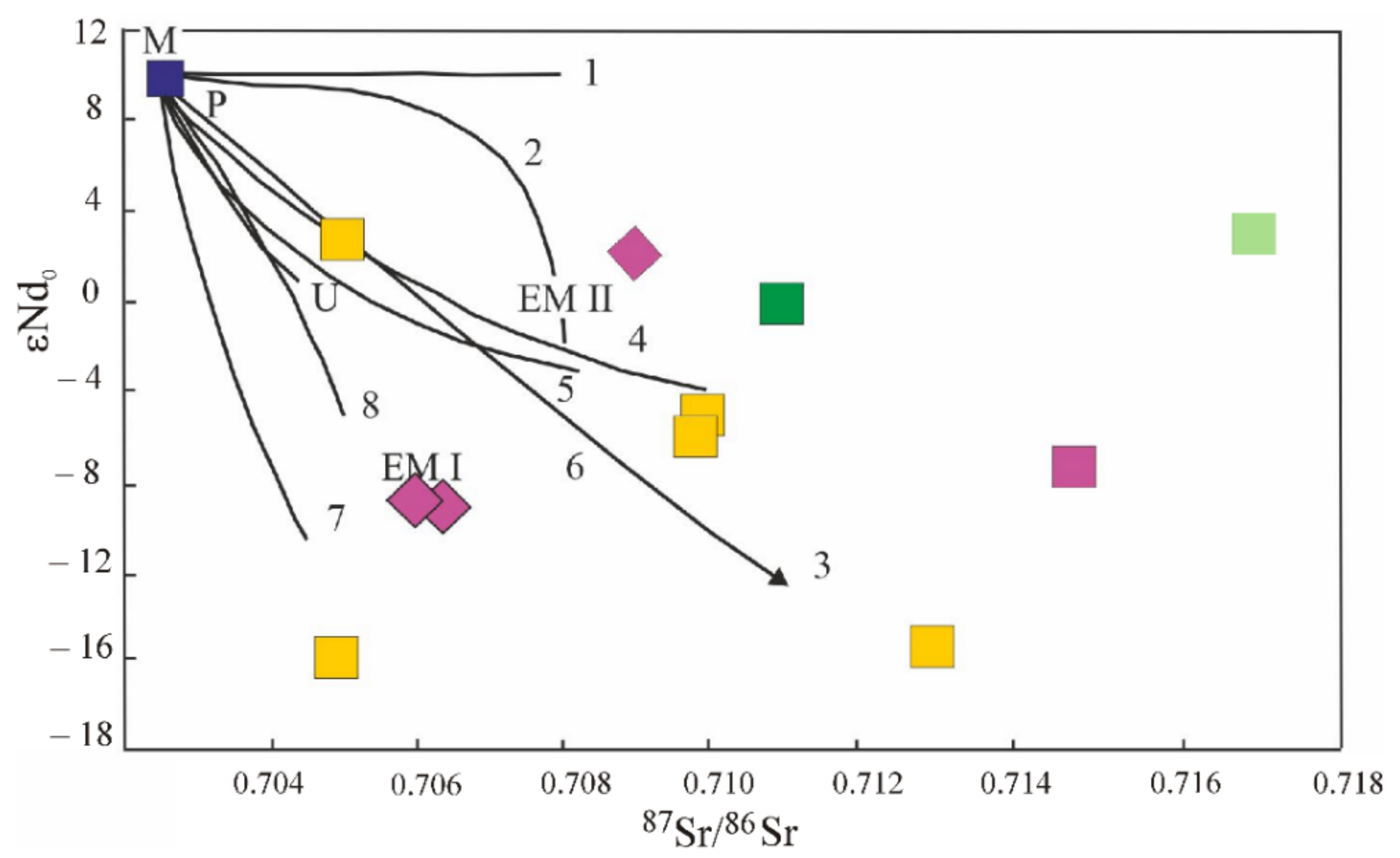

| Modal Mineral Assemblage | |||||
|---|---|---|---|---|---|
| Group | Sample | Rock | Primary | Accessory | Secondary |
| Group I Boninite | 293–16 | Basaltic- andesite | Relics of Diopside–augite, plagioclase | Apatite | Actinolite, chlorite, epidote, biotite, titanite |
| Group II Island-arc assemblage | 307–17 | Ol peridotite | Olivine, orthopyroxene | Chromite | Amphibole: ferro-hornblende–ferro-pargasite, serpentine, talc, chrom-magnetite, magnetite |
| 294–17 | Gabbro | Diopside, plagioclase–bitownite | Ilmenite, apatite | Amphibole: actinolite–hornblende-pargasite–tschermakite, albite, scapolite, epidote | |
| 22–19 EF | Basalt | Clinopyroxen–diopside, plagioclase-bitownite | Chromite, ilmenite, apatite | Amphibole: actinolite–magnesio-hornblende–pargasite–tschermakite, chlorite, albite, epidote, scapolite | |
| 24/1–19 WF | Basaltic-andesite | Plagioclase-oligoclase | Ilmenite, Rutile, apatite, zircon | Amphibole: actinolite–magnesio-hornblende, albite, epidote, sericite, titanite | |
| 19b–19 | Andesite | Plagioclase: oligoclase–andesine–labrador, potassiumfeldspar, biotite, quartz | Monazite, apatite, ilmenite, zircon | Amphibole: magnesian hornblende, albite, chlorite, garnet—almandine–spessartine, epidote, scapolite, muscovite, titanite | |
| 35–18 | |||||
| 310–16 | |||||
| 47–19 | |||||
| 314–16 | |||||
| Group III E-MORB | 313–16 | Basalt | Relics of diopside–augite, plagioclase: labrador–bitownite | Ilmenite, apatite | Amphibole: actinolite–vagnesio-hornblende–pargasite–tschermakite, chlorite, talc, albite–oligoclase, biotite, sericite |
| Group IV OIB | 93–17 | Trachybasalt | Hornblende, albite, epidote, biotite | Ilmenite, apatite | Amphibole: magnesio-ferro-hornblende, biotite, albite, epidote, garnet, sericite, titanite |
| 18–19 | Peridotite | Relics of clinopyroxene–diopside–augite, plagioclase–labradorite | Ilmenite, apatite, zircon | Actinolite, chlorite, albite-oligoclase, biotite, epidote, titanite, new-formed zircon | |
| 17–19 | Melano gabbro | Relics of clinopyroxene–diopside–augite | Ilmenite, apatite, zircon | Amphibole: ferro hornblende–ferro pargasite, albite–oligoclase, biotite, epidote, titanite, new-formed zircon | |
| 7a–19 | Gabbro | Relics of clinopyroxene–diopside–augite and plagioclase–labradorite | Ilmenite, apatite, zircon | Amphibole: actinolite–ferro-hornblende, albite–oligoclase, biotite, epidote, titanite, new-formed zircon | |
| 14–19 | |||||
| 3–19 | Monzo-gabbro | Clinopyroxene–diopside–augite, plagioclase–labradorite, potassium feldspar, biotite | Ilmenite, baddeleite, apatite, zircon | Amphibole: ferro-hornblende–ferro-edenite–ferro-pargasite, plagioclase: albite-oligoclase, Epidote, titanite, new-formed zircon | |
| 19a–19 | |||||
| Geochemical Type/Rock | [Δ Nb] | Age | ΕNd(T) | T (DM) Ga | Reference |
|---|---|---|---|---|---|
| Group I | −0.2 | 833 Ma (U–Pb) | +5.23 | 1.4 | This work |
| Group II | (−1.27)–(+0.08) | 833 Ma (U–Pb) | +0.17–(−11.7) | 0.8–2.3 | This work |
| Group III | (+0.1)–(+0.3) | 833 Ma (U–Pb) | +3 | 1.6–3.4 | This work |
| Group IV Trachybasalt Diabase dike | +0.2 +0.3 | 833 Ma (U–Pb) 799 Ma (40Ar/39Ar) | +0.11 +0.1–(−2.2) | 1.5–1.8 | This work |
| Dunzhugur ophiolite massif | No data | 1020 Ma (U–Pb) | +1.5–(−1) | 1.6–1.8 | [29] |
| Ospa-Kitioi ophiolite massif | No data | 1020 Ma (U–Pb) 1035 Ma (U–Pb) | (+4.3)–(−2) | No data | [32,33] |
| Shishkhid island arc complex with supra-subduction ophiolite | No data | 850–800 Ma (U–Pb) | (+3.3)–(+6.9) (two samples yielded the values of 0.0) | No data | [4] |
| Sarkhoi continental arc complex | No data | 782 Ma (U–Pb) | −0.6–(−9.2) | 1.5–2.3 | [60] |
| Oka accretionary prism (clastic sediments and felsic volcanic rocks) | No data | 800 Ma (U–Pb) 775 Ma (U–Pb) | −0.5–(−9.1) −4.8–(−1.1) | 1.5–2.3 1.5–1.9 | [4,21,60,76] |
| Sumsunur tonalite sincollisional plutons | No data | 785–811 Ma (U–Pb) | +13.2–(−12.3) | 2.4–2.5 | [4,54] |
| TTG Gargan block | No data | 3100–2000 Ma (U–Pb) | (+1.3)–(−0.2) | 2.9–3.0 | Unpublished data by Turkina O.M., [77] |
Publisher’s Note: MDPI stays neutral with regard to jurisdictional claims in published maps and institutional affiliations. |
© 2022 by the authors. Licensee MDPI, Basel, Switzerland. This article is an open access article distributed under the terms and conditions of the Creative Commons Attribution (CC BY) license (https://creativecommons.org/licenses/by/4.0/).
Share and Cite
Kiseleva, O.; Serov, P.; Airiyants, E.; Travin, A.; Belyanin, D.; Nharara, B.; Zhmodik, S. Nd-Sr Isotopic Study of Magmatic Rocks and 40Ar/39Ar Dating of the Mafic Dike of the Proterozoic Ulan-Sar’dag Ophiolite Mélange (Southern Siberia, East Sayan, Middle Belt, Russia). Minerals 2022, 12, 92. https://doi.org/10.3390/min12010092
Kiseleva O, Serov P, Airiyants E, Travin A, Belyanin D, Nharara B, Zhmodik S. Nd-Sr Isotopic Study of Magmatic Rocks and 40Ar/39Ar Dating of the Mafic Dike of the Proterozoic Ulan-Sar’dag Ophiolite Mélange (Southern Siberia, East Sayan, Middle Belt, Russia). Minerals. 2022; 12(1):92. https://doi.org/10.3390/min12010092
Chicago/Turabian StyleKiseleva, Olga, Pavel Serov, Evgenia Airiyants, Aleksey Travin, Dmitriy Belyanin, Brain Nharara, and Sergey Zhmodik. 2022. "Nd-Sr Isotopic Study of Magmatic Rocks and 40Ar/39Ar Dating of the Mafic Dike of the Proterozoic Ulan-Sar’dag Ophiolite Mélange (Southern Siberia, East Sayan, Middle Belt, Russia)" Minerals 12, no. 1: 92. https://doi.org/10.3390/min12010092
APA StyleKiseleva, O., Serov, P., Airiyants, E., Travin, A., Belyanin, D., Nharara, B., & Zhmodik, S. (2022). Nd-Sr Isotopic Study of Magmatic Rocks and 40Ar/39Ar Dating of the Mafic Dike of the Proterozoic Ulan-Sar’dag Ophiolite Mélange (Southern Siberia, East Sayan, Middle Belt, Russia). Minerals, 12(1), 92. https://doi.org/10.3390/min12010092






